“A lovely church designed by the Rev. John D. McCollough.” – The Herald reported on July 8th, 1880 – “Mr. T.C. Ward, a capable carpenter, has recently completed a prescription case for T.C. Robertson and Co., and a reading desk for the Episcopal Church.” The Herald reported on Dec. 9, 1880 – The partnership of Ward and Parkinson has been dissolved. Mr. T.C. Ward will continue the business.”
City Directories and History: 1908 – Rev. R. Maynard Marshall – Rector
The Episcopal Church of Our Saviour, while not the oldest congregation in Rock Hill, occupies the oldest church sanctuary. The building at the corner of
Caldwell and East White Streets was built in 1872 as a simple Gothic Revival frame chapel with board and batten siding, attributed to the designer, Rev. John D. McCollough. It has undergone a number of changes over the years. In 1895, the vestibule was added. In 1908, the greatest alterations took place, when the transepts, chancel, and tower were added and the

Postcard image courtesy of the Turner Collection – 2012
church was encased in brick. The two-story tower has a crenellated parapet, buttresses at the corners, and pointed arched openings with wood shutters. The first stained glass windows were added at this time as well. Additional impressive windows have been placed in the church over the years. In 1922 the Parish Hall was constructed adjacent to the sanctuary along Oakland Avenue. This building contained the first indoor gymnasium available to the public in Rock Hill. In 1963, the nave of the church was enlarged on both sides and the front porch was added. The Parish hall was demolished in 1990 and a new one erected on the same site, with space for classrooms, offices, and indoor and outdoor gathering spaces.
The Yorkville Enquirer reported June 16, 1870 – “A public festival will be held at Rock Hill on June 21st to except contributions for building an Episcopal Church.” Later on May 16, 1872 the paper reported – “An Episcopal Church, to be called the Church of Our Saviour is to be erected at Rock Hill. It is to be finished by the 15th of August.”
On June 6th 1872 the paper further reported – “The new Episcopal Church at Rock Hill is being rapidly being pushed to completion.” Later on Aug. 8th the paper reported – “The right Rev. Bishop Howe of the Prot. Espiscapol Church has begun his annual tour throughout the state. On Sept. 15th he will consecrate the new Rock Hill Church.” Later on Sept. 26th the Enquirer reported – “The Church of Our Saviour, the new Episcopal Church of Rock Hill, was consecrated by Bishop Howe.”
The Episcopal Church of Our Saviour retains its Gothic Revival character even though it has undergone extensive changes over the years, and it contributes to the varied and rich church architecture in the downtown area. The building is listed in the National Register of Historic Places as part of the Rock Hill Downtown Historic District.

Images courtesy of photographer Bill Segars – 2007
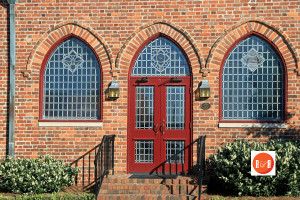

ROCK HILL’S OLDEST CHURCH BUILDING – Contributed and written for R&R by P. M. Gettys
The Episcopal Church of Our Saviour, while not the oldest congregation in Rock Hill, occupies the oldest church sanctuary. The building at the corner of Caldwell and East White Streets was built in 1872 as a simple Gothic Revival frame chapel with board and batten siding. It has undergone a number of changes over the years. In 1895, the vestibule was added. In 1908, the greatest alterations took place, when the transepts, chancel, and tower were added and the church was encased in brick. The two-story tower has a crenellated parapet, buttresses at the corners, and pointed arched openings with wood shutters. The first stained glass windows were added at this time as well. Additional impressive windows have been placed in the church over the years. In 1922 the Parish Hall was constructed adjacent to the sanctuary along Oakland Avenue. This building contained the first indoor gymnasium available to the public in Rock Hill. In 1963, the nave of the church was enlarged on both sides and the front porch was added. The Parish hall was demolished in 1990 and a new one erected on the same site, with space for classrooms, offices, and indoor and outdoor gathering spaces.
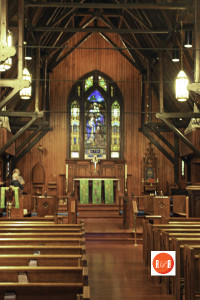
Images courtesy of photographer Bill segars – 2015
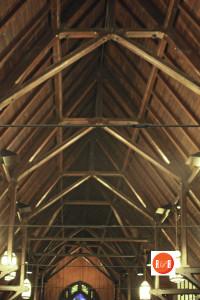
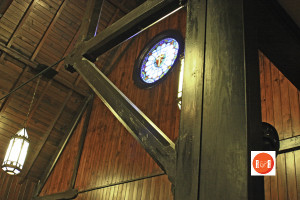

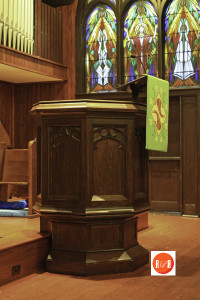

The Herald reported on Oct. 6, 1887 – “Mrs. Morrison has removed her boarding house to the residence adjoining the Episcopal Church. She is vacating the Workman House, and Mr. Piquard has moved into it.”
The Episcopal Church of Our Saviour retains its Gothic Revival character even though it has undergone extensive changes over the years, and it contributes to the varied and rich church architecture in the downtown area. The building is listed in the National Register of Historic Places as part of the Rock Hill Downtown Historic District.
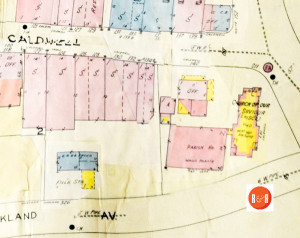
Sanborn Insurance Map of the subject, 1926 – 1959. Courtesy of the Galloway Map Collection.
The SC Architects: 1885 – 1935, Wells and Dalton, 1992 reported, “the Episcopal Church of our Savior was designed by architect, J.D. McCullough and completed in 1872.”
On May 18, 1876 the YK Enquirer reported – “John Kennedy, colored, the former sexton of the Episcopal church at Rock Hill stole from the church bibles, pray books and other texts. He then absconded before being found out and warrants have been issued for his arrest.”
The RH Herald reported on May 13, 1880 – “A new and beautiful chandelier now hangs in the Episcopal Church in Rock Hill.”
The Herald reported on May 10, 1883 – “The Episcopal congregation of Rock Hill has placed a marble table in the church to the memory of Rev. R.P. Johnson.”
The Rock Hill Herald reported on Jan. 22, 1885 – “A beautiful memorial window has been placed in the Episcopal Church in the rear of the chancel in memory of the late Roberts P. Johnson, the former Rector. It is of stained glass and it is beautiful in conception and artistic in execution.”
The Yorkville Enquirer reported on Oct. 8, 1890 – “The Episcopal Church has secured a new and larger organ.”
On Feb. 25, 1891, the Yorkville Enquirer reported – “The new organ for the Episcopal Church in Rock Hill has arrived and has been placed into position. Also electric lights were placed in the church today.”
The Herald reported on July 4, 1900 – “Mr. H.A. Brown has the contract to repaint the interior of the Episcopal Church. The ceiling is to be a very pretty blue, the walls green, and the altar and railing white, while the columns will be guided with gold.”
The Herald reported on Aug. 11, 1906 – That the church congregation has voted to improve the church. An extension will add to the seating capacity, and the walls will be brick cased.
The Rock Hill Record reported Sept. 17, 1907 – “The Episcopal congregation will hold services at City Hall during the erection of their new church. Workman are already tearing away the old church building.”
The RH Record reported on Oct. 17, 1907 – “Work is progressing on the new Episcopal Church.”
On Dec. 19, 1907 – “The work on the new Episcopal Church of this city, under the supervision of J.J. Keller Contractors, is progressing very nicely and the building is now beginning to look very much like a church, and when completed will be a very attractive structure.”
The Record also stated on March 30, 1908 – “The new edifice for the congregation of the Episcopal Church is fast nearing completion, and is now even presenting a very attractive appearance. It is built along fine lines and is a credit to J. J. Keller and Co., the contractors in charge.”
On May 4, 1908 the Record stated – “A beautiful memorial window has been placed in the chancel of the Church of Our Savior as a memorial to the late Mr. John R. London, who died June 1, 1904. The scene is the adoration of the infant Savior.
The RH Record of May 6, 1909 stated, “Mr. R.E. Brocone, the Southern Agent, has moved his family into the Episcopal Rectory, recently vacated by the family of the late Capt. Clark.”
The Herald reported on Oct. 5, 1918 – “At a congregational meeting the Episcopal Church gave unanimous approval for the recent action of the vestry in buying adjacent property. After the war, they plan to erect a parish house on this property for their work with young people. They are raising funds for this property and for the improvements upon the house to be used as the rectory.”
The Herald reported on Dec. 16, 1918 – “Rev. Guy H. Frazer and family are now in the Episcopal Rectory on the lot adjacent to the Church of Our Saviour on Caldwell Street.”
On July 8, 1920 the Herald reported, ” Rock Hill Episcopalians voted at a congregational meeting to build a rectory on College Ave., and to build a parish house on Caldwell Street adjoining the church. The rectory will be between Aiken and WTS and will be seven rooms and cost approximately $7,500. The parish house will be of brick and will cost about $20,000. The building committee consist of R.L. Sturgis, John G. Barnwell, and W.P. Goodman.”
The Herald reported on March13, 1922 – “This afternoon the cornerstone of the Parish House adjoining the Church of Our Savior will be laid. With Bishop K.G. Finlay officiating.”
Click HOME to return to the numbered site tour of Rock Hill’s downtown.
Stay Connected
Explore history, houses, and stories across S.C. Your membership provides you with updates on regional topics, information on historic research, preservation, and monthly feature articles. But remember R&R wants to hear from you and assist in preserving your own family genealogy and memorabilia.
Visit the Southern Queries – Forum to receive assistance in answering questions, discuss genealogy, and enjoy exploring preservation topics with other members. Also listed are several history and genealogical researchers for hire.
User comments welcome — post at the bottom of this page.
Please enjoy this structure and all those listed in Roots and Recall. But remember each is private property. So view them from a distance or from a public area such as the sidewalk or public road.
Do you have information to share and preserve? Family, school, church, or other older photos and stories are welcome. Send them digitally through the “Share Your Story” link, so they too might be posted on Roots and Recall.
User comments always welcome - please post at the bottom of this page.
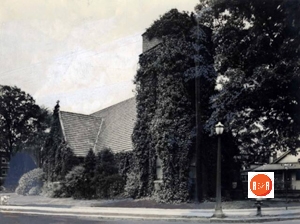


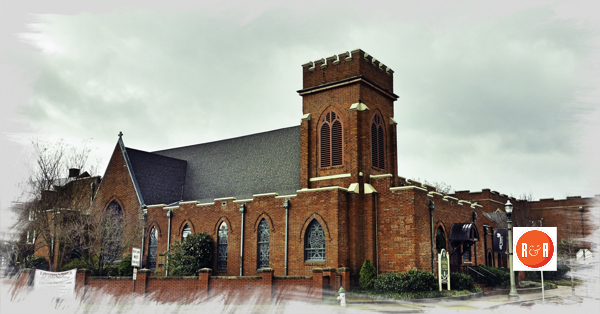





Share Your Comments & Feedback: